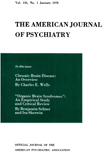THE RELATIONSHIP BETWEEN HIGHEST MENTAL CAPACITY AND PSYCHIC ABNORMALITIES
Abstract
The hereditary background and the physical and mental health conditions of 294 geniuses and their families were investigated. We regret the anonymous character of the reported results and realize that the reader would be more attracted by references to definite personalities in the row of geniuses; the confidential nature of information obtained by personal interview, however, put us under obligation to omit names and personal circumstances.
Without repetition of the details given in the preceding chapters, the most important results are summarized in the following conclusions:
1. There is no definite relationship between highest mental capacity and psychic health or illness, and no evidence to support the assumption that the genesis of highest intellectual ability depends on psychic abnormalities. The high number of mentally healthy geniuses speaks against such a claim and repudiates the slogan "genius and insanity." Psychoses, especially schizophrenia, proved to be detrimental to creative ability. Milder psychic abnormalities within the limits of psychoneurosis such as the combination of emotional instability and psychic tension exerted in some instances a stimulating influence.
2. The geniuses were not at a disadvantage in comparison with the average population relative to life duration, fertility, and disposition to organic diseases in the sense of a diminished vitality as the price of intellectual supremacy.
3. There seems to be a tendency in the genesis of high mental faculty to manifest itself in first- and second-born children.
4. The families of geniuses do not "die out." The supreme mental ability of a genius is reflected in the remarkably high number of intellectually prominent individuals among his children and grandchildren.
5. The process by nature of making a genius is obviously a very complex one and involves different not clearly understood mechanisms. A direct hereditary transmission is probable in the fields of music, painting, mathematics, and technical invention. In general, there must be a preparatory ground in form of certain talents in the ancestors, and in combination with optimal character traits without the dysharmony of strong conflicting tendencies. Manual dexterity in the ancestors of artists, rhetorical talents in those of the poets, and philosophic-theologic-didactic talent in the ancestors of scientists are conspicuous predisposing factors for the formation of a genius.
6. Eminent artistic talents were frequently found in combinations such as music and poetry, music and painting, and painting, sculpture, and architecture.
7. There seems to be a relative incompatibility or compatibility between the make-up of a genius and certain psychic dispositions. The schizothymic constitution is more prevalent among the artists and the cyclothymic constitution among the scientists, especially those in the natural science group.
8. The geniuses and their families show a much higher incidence of psychosis and psychoneurosis than the average population. Among the geniuses themselves, schizophrenia occurred only in the artists, and manic-depressive insanity only in the scientists, in a frequency 10 times the incidence of the average population. The eccentrics (schizothymic) were correspondingly more prevalent among the artists, and the emotionally unstable psychopaths (cyclothymic) were more frequent among the scientists.
9. A comparison between the artists and scientists showed a relative biologic inferiority of the artists exhibited by the higher number of psychic abnormalities among themselves and their families, the lower fertility and shorter life span, the higher number of single persons and illegitimate children, the increased infant mortality, and the higher divorce rate. No difference between the two groups existed relative to physical health.
10. The incidence of below-average intellect and imbecility is remarkably low in the descendants of the geniuses, whereas the suicide rate appears to be high.
11. The wives of the geniuses were, in the overwhelming majority, excellent marriage companions and contributed directly or indirectly to the outstanding accomplishments of their husbands.
12. The geographic-racial descent of the geniuses revealed a selective distribution of certain talents. The artists were most numerous in the southern and southeastern parts within the German-speaking boundaries, and the scientists in the northern and western districts. No district, however, was exclusively limited to either of the two groups. The greatest total number of geniuses came from the thickly populated and racially mixed middle regions of Germany and Switzerland. The optimal mixture of related races seemed to be a favorable factor for the formation of geniuses.
Access content
To read the fulltext, please use one of the options below to sign in or purchase access.- Personal login
- Institutional Login
- Sign in via OpenAthens
- Register for access
-
Please login/register if you wish to pair your device and check access availability.
Not a subscriber?
PsychiatryOnline subscription options offer access to the DSM-5 library, books, journals, CME, and patient resources. This all-in-one virtual library provides psychiatrists and mental health professionals with key resources for diagnosis, treatment, research, and professional development.
Need more help? PsychiatryOnline Customer Service may be reached by emailing [email protected] or by calling 800-368-5777 (in the U.S.) or 703-907-7322 (outside the U.S.).



